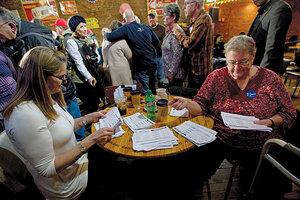Democratic voters head to the polls. Three questions about primary season.
With the Iowa caucus, the starting gun for the presidential primary season will officially go off. Here’s what to look ahead to in the months to come.

Volunteers sort through commitments to a candidate during a Democratic campaign event at the Smokey Row in Oskaloosa, Iowa, Jan. 25, 2016.
MARY ALTAFFER/AP/FILE
To journalists, pundits, and political junkies, the 2020 presidential election has been in full swing for over a year. But for many Americans, it’s just getting started. Beginning with Iowa on Feb. 3 and going through June, all 50 states, every United States territory, and the District of Columbia will cast votes to determine who should be the Democratic presidential nominee facing off against President Donald Trump in the general election in November.
How does the primary system work?
Nominees used to be chosen behind closed doors at the party convention by delegates – who were mostly middle-aged, middle-class white men, as former Democratic presidential nominee George McGovern once put it. After the riots at the 1968 Democratic National Convention, the party decided to reform the process and make it more democratic.
The state-by-state primary system was largely put in place by 1976 – allowing Jimmy Carter, a little-known peanut farmer and former Georgia governor, to win the Democratic nomination that year. Under the old system of nomination by party bosses, “Jimmy Carter would have stood no chance,” Jody Powell, one of President Carter’s closest aides, told NPR.
Today, most states hold primaries, which are similar to general elections (think polling places and private voting booths). A handful of states – just three this year on the Democratic side, along with some territories – hold caucuses.
In Iowa’s Democratic caucuses, participants will arrive at their designated location – which could be anything from a community center to someone’s living room – and cluster with others who support the same candidate. To be determined “viable,” a candidate must receive the support of at least 15% of those in the room. If a candidate does not reach that threshold, then he or she is considered “nonviable” and his or her supporters have the option to “realign” with a different candidate. This year, with so many Democratic candidates in the race, there could be a great deal of realigning – making second or third choices key.
Why is there so much buzz around Iowa?
As the saying goes, “Winning begets winning.”
Iowa (Feb. 3), New Hampshire (Feb. 11), Nevada (Feb. 22), and South Carolina (Feb. 29) will be the first four states to hold primaries and caucuses. In previous cycles, candidates have been able to generate significant momentum out of wins in these states, and they spend a great deal of time campaigning on the ground there ahead of the elections. Racking up early wins can signal to voters (and donors) in other states that a candidate is electable.
There have long been debates about how to make the primary process even more democratic. Critics contend that too much weight is given to the first two states, Iowa and New Hampshire, in particular. Both are far less diverse – at around 91% and 93% white, respectively – than the Democratic Party, or the country as a whole.
In 2008, the Democratic Party moved the Nevada caucuses and South Carolina primary up on the calendar, putting them right after Iowa and New Hampshire, in an effort to give a more prominent role to more diverse states.
What about the rest of the states?
On Super Tuesday (March 3) voters in 14 states – representing more than one-third of the country’s population – will cast votes for a Democratic nominee. By mid-March, 60% of the party’s delegates will have been awarded. Perhaps in anticipation of that, candidates have spent somewhat less time campaigning in Iowa and New Hampshire than in previous cycles, and more time in places like California – one of the states that will vote on Super Tuesday.
That said, the outcomes of the early four states will still matter – and could heavily affect what happens in subsequent contests. If the results in Iowa and New Hampshire are close, most or even all of the candidates may move on; if not, some will likely be forced to drop out of the race. One thing that will be interesting to watch is how the four senators running for president will juggle campaigning in the early states with their obligations in Washington around the impeachment hearings.

